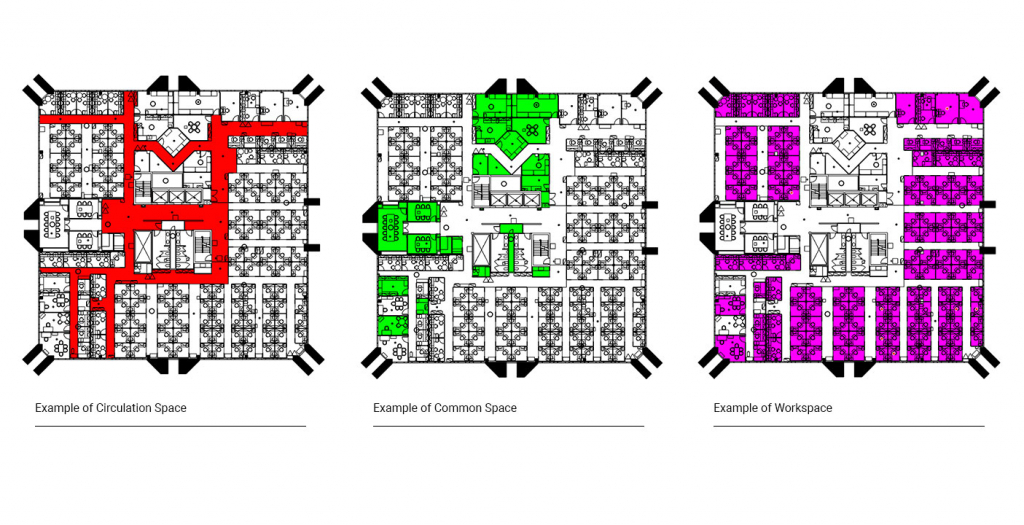What is Space Recharge
Space recharge, otherwise known as chargeback, involves charging departments for the space they use. For example, space Recharge charges business units for workspace and charges a portion of common areas and circulation space. Why do businesses charge their departments for space? Space in buildings is expensive. It’s one of the highest expenses an organization will payout. Therefore, by requiring departments to pay for space, department managers will be more inclined to optimize their usage, which means less wastage and lower space costs. In addition, chargeback enables organizations to understand the profitability of each department by measuring the cost each team incurs through space usage. But how do you recharge your office space?
How does chargeback work?
Polylines
Initially, your floor plans must be polylined to an agreed standard. Polylines are vital as they indicate the square footage of each component on your floor plan. In addition, polylines are the ‘link’ between the drawings and your space management system.
Space Standards
You can apply space standards to areas on the drawing once the floor plans are polylined. Space standards are crucial to recharging your space as they outline how you measure and categorize space.
They indicate what that space is (occupant area, shared space, circulation) and whether or not it is occupiable. Typically, space is categorized using BOMA, IFMA, RICS, and OSCRE standards. However, most organizations will modify these standards to fit their needs.
Cost Per Area
Cost Per Area (CPA) is fundamental to chargeback. CPA tells you how much your space costs per square foot (SQFT). CPA = Building Cost/ Building SQFT.
Prorate
Prorate is a category that you assign each space, indicating the level you wish to charge each area.
It has the following options:
- Cost Center – A cost center is simply the department that owns the space. Suppose you prorate the space to a cost center. In that case, only the department will pay for it—for example, enclosed offices and open plan workstations.
- Floor level – This indicates that every department (cost center) on the floor will pay for a portion of this space—for example, meeting rooms and breakout areas.
- Building Level – This indicates that every department (cost center) in the building will pay for a portion of this space—for example, hot desks and cafeterias.
- Site Level – This indicates that every department (cost center) in the entire site will pay for a portion of this space—for example, gyms and server rooms.
How to recharge your office space
The total area that a department has to pay for is known as the chargeable area. You calculate the chargeable area at the floor level, building level, and site level. The Chargeable Area = Assigned Area + Share of Common Space + Share of Circulation Space.
Definitions
- Assigned Area = Total square feet of workspace a department owns
- Common Space = The common areas (Cafeterias, Meeting Rooms, and File Rooms) of a floor/building/site available for all departments to use.
- Share of Common Space = The portion of shared space (SQFT) that a department is forecast to use based on the assigned area.
- Circulation Space (Primary and Secondary) = Primary circulation connects the building core (stairs, lifts, toilets) and common spaces. Secondary circulation includes the aisles between individual spaces (offices and cubicles).
- Share of Circulation Space = The portion of circulation space (SQFT) that a department is forecast to use based on the assigned area.

let's walkthrough chargeback
Floor Level
1) On the 3rd floor, the total area of all the workspace is 3,135 SQFT.
Finance owns 46 desks which is an assigned area of 2,320 SQFT. Meaning they own 74% of the workspace on that floor.
2) The total common space (meeting rooms, kitchenette, file rooms) for residents on the 3rd floor is 1,055 SQFT. Because finance owns 74% of the workspace on the 3rd floor, they must pay for 74% of the Common Space. That means that finance will pay for 781 SQFT of common space on the 3rd floor.
3) You do the same calculation for circulation too. Again, there is 2,035 SQFT of circulation space. That means finance will pay for 1506 SQFT of Circulation Space (74%).
4) In total, the Chargeable Area for Finance on the 3rd floor is 4,607 SQFT (2,320 SQFT +781 SQFT + 1,506 SQFT).
Building & Site Level
We’ve worked out how much space Finance will pay for on the 3rd floor. We now have to figure out how much common space and circulation space finance will pay throughout the building.
1) The building’s total assignable area is 58,173 SQFT.
The 2,320 SQFT that Finance owns on the 3rd floor is 4% of all workspace throughout the building.
2) The amount of Common Space (Board rooms, Cafeterias) used by residents in the whole building is 12,433 SQFT. Because finance owns 4% of the building’s workspace, they will pay for 4% of its common space.
That means finance will pay for 497 SQFT of building common space.
3)There is 20,055 SQFT of circulation space throughout the building, so finance will also pay for 4% of this.
That means that finance will pay for 802 SQFT of building circulation space.
4) Now, it’s a case of putting it all together. So, we start with the 3rd floor chargeable area (4,607 SQFT). Then, add the 497 SQFT of building common space and the building circulation space (802 SQFT), yielding finance a total chargeable area of 5,906 SQFT.
5) We’ve identified how much space finance needs to pay for in our building. Now we need to put a value on it. To do this, take the total chargeable area and multiply it by your cost per area. For example, 5,906 SQFT X £112 = £661,472 per year.
Recharge involves departments paying for space they own. Recharging your office space means less wasted workspace and lower space costs




